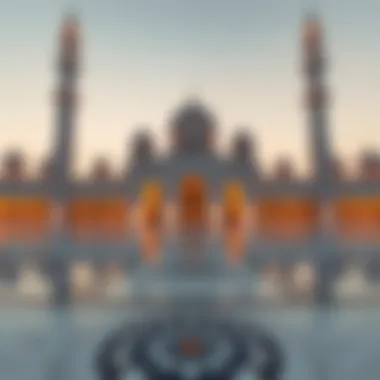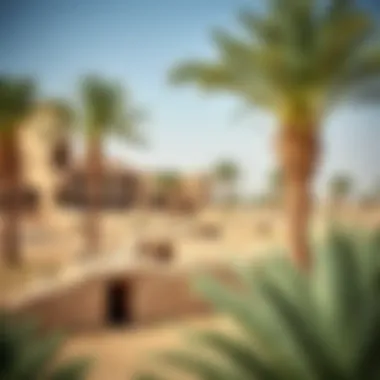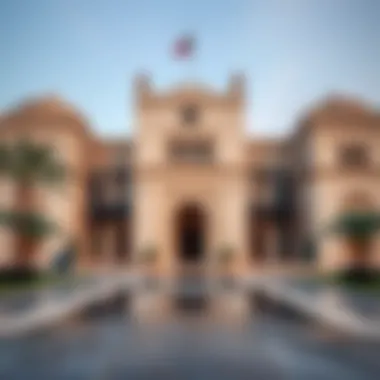Cultural Heritage Sites in the UAE: Journey Through Time


Intro
The United Arab Emirates, often known for its modernity and rapid development, has a rich tapestry of cultural heritage that deserves attention. This collection of sites offers a glimpse into the long history, diverse traditions, and transformative journey of the nation. Examining cultural heritage sites in the UAE is not just about appreciating the beauty of architecture; it’s about understanding the roots from which contemporary Emirati identity springs.
Across the emirates, from Abu Dhabi to Sharjah, historical forts, traditional markets, and ancient settlement ruins can be found. They tell unique stories of the people who lived there and how their customs evolved over time. This exploration invites both residents and visitors to engage with the past, promoting a sense of pride and appreciation for the cultural landscape.
In comparing these heritage sites, one can grasp how they serve as anchors of tradition that stand alongside the ultramodern skyscrapers. The juxtaposition is striking, embodying the UAE's spirit of innovation while paying homage to its rich history. This journey through the cultural sites encourages a dialogue on the preservation of heritage in an age of relentless change.
Through this narrative, we don't simply observe; we begin to understand the substantial impact these sites have on today's society, shaping the cultural and social fabric of the UAE. As we delve deeper, we will analyze various landscapes of heritage, reflecting on their significance and relevance in the modern world.
Understanding Cultural Heritage in the UAE
Cultural heritage in the UAE is like a thread weaving together the fabric of the nation’s identity. It encompasses the traditions, monuments, and practices that have shaped the lives of Emiratis over centuries. Understanding this cultural heritage is crucial, not just for those who live in the UAE, but also for investors and professionals looking to tap into the market.
This article delves into the historical richness of the UAE, contextualizing modern developments against the deep roots of its past. By appreciating the nuances of Emirati cultural practices and historical sites, stakeholders can navigate the real estate landscape with greater foresight.
Defining Cultural Heritage
Cultural heritage can be broadly defined as the legacy of physical artifacts and intangible attributes of a group or society inherited from past generations. In the UAE, this extends from archaeological sites, traditional crafts, and oral histories to significant structures such as forts and mosques.
In essence, the cultural heritage reflects the collective memory of a society, being a touchstone for identity and community cohesion.
- Tangible Heritage: This includes monuments, buildings, and artifacts, such as the Al Ain Oasis, that exemplify Emirati architecture and agricultural practices.
- Intangible Heritage: This refers to customs and traditions, like falconry and traditional dance, reflecting the nation’s values and social practices.
Through this lens, cultural heritage is not just about preservation. It actively shapes current and future generations’ understanding of who they are and where they come from.
The Role of Heritage in Nation-Building
Heritage serves as a crucial pillar in the nation-building process of the UAE. It is the well from which the country draws its identity and pride. The government has recognized this relationship and has taken significant steps to promote and preserve it.
In the broader context of nation-building, cultural heritage offers several benefits:
- Unity: Shared traditions and historical narratives foster a sense of belonging among citizens regardless of diverse backgrounds.
- Tourism: Heritage tourism has become a big draw, enticing visitors to explore locations like the Sheikh Zayed Grand Mosque and Dubai Museum. This brings economic growth and global visibility.
- Education and Awareness: Incorporating cultural heritage into educational systems enlightens youth about their history, encouraging civic responsibility and cultural pride.
- Innovation: By understanding and valuing the past, there are opportunities to innovate and adapt traditional practices to contemporary contexts, ensuring they remain relevant.
In a nutshell, the role of cultural heritage is multidimensional, contributing not just to the preservation of the past but to the formulation of a cohesive and aspirational national identity.
"Understanding cultural heritage isn’t just about looking back; it's about setting a foundation for a future rooted in history."
The exploration of cultural heritage sites across the UAE reveals a landscape rich with stories waiting to be told. This journey through time not only honors the elegance of the past but also illuminates the path forward for the UAE.
The Historical Context of the UAE
Understanding the historical context of the United Arab Emirates is crucial for grasping how its cultural heritage has shaped contemporary society. This narrative provides the foundation for exploring the nation's proud identity and the evolution of its cities and communities. Key aspects of the UAE's past illuminate the values, traditions, and customs that persist today, fostering a deeper appreciation among residents and visitors alike for the rich tapestry that forms the nation's cultural framework.
By delving into the early civilizations and subsequent settlements, one can discern the footprints left by various peoples throughout history. This awareness not only instills pride but also encourages investment and interest in preserving these invaluable resources.
Early Civilizations and Settlements
The history of the UAE is not merely a recent phenomenon; it reaches back thousands of years. Archaeological discoveries such as the Al Ain Archaeological site reveal that early human habitation dates back to around 8000 BCE. These settlements included the Hafit Period where tribes formed complex societies primarily based on fishing, trading, and agricultural practices.
The region was strategically located along trade routes connecting the Arabian Peninsula with the wider world, serving as a melting pot of cultures and ideas. Settlements, particularly in places like Umm Al-Quwain and Sharjah, were notable for their distinctive pottery and other artifacts, pointing to a vibrant exchange between early residents and civilizations from Mesopotamia and beyond.
- Key elements of early civilization include:
- Fishing and Pearling: Communities thrived on the rich maritime resources.
- Trade: Facilitated not only economic growth but cultural exchange as well.
- Agriculture: Established roots on the fertile land, particularly around oases.
In turn, these factors laid the groundwork for later developments in the UAE. Understanding these roots helps create a full picture of how heritage shapes both identity and the future trajectory of the nation.
The Formation of the Emirates
The modern formation of the Emirates stems from a confluence of social, economic, and political factors. The discovery of oil in the 20th century drastically transformed the UAE's landscape, steering it into an era of swift modernization and urbanization. However, it was the treaties and alliances formed between local rulers that truly established the United Arab Emirates as a unified entity.
Initially, the Trucial States consisted of several independent sheikhdoms, each with its own leadership and governance. In 1971, these sheikhdoms came together, driven by a shared need for security and economic stability, to form what we now know as the UAE.


- Key milestones in the formation of the Emirates include:
- British Protection: The arrangement with Britain helped to establish peace.
- Declaration of Unity: Achieved on December 2, 1971, marking the birth of a nation.
- Rapid Development: Led to investments in infrastructure, healthcare, and education.
This context highlights the fundamental interconnections between past and present, reflecting a continuous evolution rooted in tradition and innovation. The formation of the UAE is a testament to the resilience of its cultural identity, further emphasizing the significance of preserving heritage sites to maintain the stories of old for future generations.
Prominent Heritage Locations
The United Arab Emirates is home to a trove of cultural heritage sites that speak to its remarkable past and evolving identity. Understanding these prominent heritage locations goes beyond mere sightseeing; it offers an intimate glimpse into the essence of Emirati culture. Visitors are often struck by the blend of ancient traditions and modernity, making these sites not just cultural treasures but also vital components in the narrative of the UAE's development.
Al Ain Oasis
Historical Importance
Al Ain Oasis is more than a patch of green in the arid landscape; it represents the cradle of Emirati civilization. Its historical significance lies in its role as a crucial settlement point for early communities. The date palms and irrigation systems showcase the ingenuity of ancient agricultural practices, enabling people to thrive in an otherwise harsh environment. Its lush landscape is a testimony to how life can flourish with smart resource management.
Architectural Features
The architecture of Al Ain Oasis stands out due to its traditional falaj system, which has been used since ancient times. These underground channels are remarkable feats of engineering designed to optimize water usage. Such structures not only provide vital irrigation but also echo the connection between the land and its people. The simplicity and functionality of the designs reflect a deep respect for the environment, making the oasis an essential location for understanding the interplay of architecture and sustainability.
UNESCO World Heritage Status
Being designated as a UNESCO World Heritage Site underscores the global importance of Al Ain Oasis. This status not only brings recognition but also enhances efforts for preservation. The unique combination of cultural and natural elements in Al Ain makes it a particularly valuable choice for the discussion of heritage. While its status aids in maintaining its integrity, it also raises awareness and encourages educational initiatives about traditional practices.
Sheikh Zayed Grand Mosque
Symbol of Unity
The Sheikh Zayed Grand Mosque is often seen as a symbol of unity and tolerance in the UAE. It isn't just an architectural marvel; its design elements combine Islamic styles from different cultures, reflecting the country's commitment to inclusion. With the hope of bringing communities together, this mosque transcends cultural barriers, making it a relevant site in any conversation about cultural heritage.
Design Elements
The design of the mosque includes features such as intricate mosaics, stunning domes, and a grand reflective pool, which serve as stunning visuals for visitors. The use of local materials—like marble—demonstrates an intent to integrate national identity into architectural practices. This not only strengthens ties to heritage but also elevates the aesthetic value of the place.
Visitor Experience
Visitors often describe their experience at the mosque as both calming and enlightening. Engaging guided tours educate attendees about Islamic customs and the mosque's history. The vast prayer hall, one of the world's largest, allows guests to appreciate the scale and beauty of Islamic architecture up close. The immersive nature of the visit encourages a deeper understanding and respect for Emirati culture.
Dubai Museum
Historical Exhibits
Dubai Museum holds a treasure trove of historical exhibits that depict the transition of the emirate from a humble fishing village to a global metropolis. Assembled artifacts range from traditional dhows to ancient coins, all telling stories that reflect economic and social changes over time. These exhibits are vital in preserving the narrative of Dubai’s origins, linking past and present in tangible ways.
Architectural Significance
The museum itself, housed in the Al Fahidi Fort, is an exemplary representation of traditional Emirati architecture. Constructed from coral stone and gypsum, it reflects a historical architectural style that contrasts sharply with the overwhelming contemporary skyscrapers surrounding it. The unique aesthetics draw visitors, who often marvel at how history can materially coexist with modernity.
Role in Preserving History
Serving as a custodian for Dubai's history, the museum plays an essential role in education and cultural preservation. Through interactive displays and guided tours, it imparts knowledge to both locals and tourists. This dual focus emphasizes how crucial it is to understand one’s roots in order to nurture a connected and informed future.
Fujairah Fort
Historic Defense Structure
Fujairah Fort stands as a reminder of the region's military history. Its strategic location on the east coast was pivotal in defending against maritime raids. The fort's impressive limestone and gypsum structure, built some 300 years ago, adds a robust character to the historical narrative of Fujairah, showcasing not only architectural resilience but also the cultural importance of security in a turbulent region.
Restoration Efforts
Efforts to restore Fujairah Fort highlight the commitment to maintaining cultural significance. Renovations preserve its historical integrity while also making it accessible to the public. Such initiatives encourage community involvement, sparking a revival of interest in local heritage, and linking the community to its past.
Cultural Insights


Beyond its defensive purpose, the fort provides rich cultural insights. It frequently hosts community events that engage residents and visitors alike, creating a bridge between past and present. The fort stands as an emblem of the ongoing dialogue about regional identity, fostering not just tourism, but community pride.
Qasr Al Hosn
Royal Heritage
Qasr Al Hosn is steeped in royal heritage and serves as the oldest stone building in Abu Dhabi. Originally constructed as a watchtower, it evolved into a royal palace and government headquarters. This transformation reflects the dynamic history of the emirate and enlarges understanding of the ruling family’s role in shaping the nation.
Historical Narratives
The narratives surrounding Qasr Al Hosn are equally integral to its cultural significance. It has witnessed significant events in Emirati history, making its walls a repository of stories. These narratives are crucial for understanding the identity of Abu Dhabi, as they resonate with the pride and aspirations of the Emirati people.
Visitation and Activities
Qasr Al Hosn attracts visitors not only for its history but also for the range of activities on offer. From art exhibits to cultural festivals, the venue serves as a dynamic hub for community engagement. This variety enriches the visitor experience, encouraging participation in the cultural dialogue that helps to shape modern Emirati identity.
Significance of Preservation Efforts
The preservation of cultural heritage is not just about maintaining old buildings or relics for aesthetic purposes; it's about safeguarding the very essence of a nation's identity. In the UAE, where growth and modernization have skyrocketed in recent decades, the significance of preserving cultural sites goes beyond nostalgia and reflects on how the past shapes the present and future. This effort ensures that the unique traditions, narratives, and architectural marvels of the UAE remain accessible to both local residents and global visitors. These sites tell stories that transcend time, offering insights into the country’s evolution and cultural richness.
Government Initiatives
The UAE government has played a pivotal role in spearheading preservation initiatives. With a firm understanding that heritage is a national asset, authorities have implemented policies and programs to protect historical sites. The establishment of the Abu Dhabi Authority for Culture and Heritage is a prime example. This body actively engages in documenting, conserving, and promoting the cultural history of the emirate.
In addition, the Sheikh Zayed Heritage Festival is an annual event that not only promotes local crafts and traditions but also strengthens community awareness regarding the importance of cultural preservation. Initiatives like these are critical in raising funds for restoration projects, improving the skills of local artisans, and ensuring that cultural narratives are passed down through generations.
Notably, the government's collaboration with UNESCO emphasizes global standards for cultural preservation. The UAE's commitment to maintaining its heritage is reflected in the growing list of UNESCO World Heritage Sites, including Al Ain Oasis and the Dubai Creek, showcasing an effective blend of modern urban life and historical legacy.
Community Involvement
Equally important is the role of community involvement in preserving cultural heritage. Local communities are the custodians of their history, and without their engagement, many cultural practices might fade into obscurity. Various grassroots movements and NGOs work diligently to involve residents in preservation efforts. For instance, community workshops focusing on traditional crafts and storytelling play a major role in keeping age-old practices alive and relevant.
“It’s not just about buildings; it’s about the people and their stories.” This sentiment resonates deeply in the UAE, where collaborative efforts between the government and local residents create a fertile ground for cultural exchange and education.
Moreover, educational programs in schools have raised awareness among younger generations about their heritage. Initiatives that encourage children to learn about their history through field trips to sites like Qasr Al Hosn and Fujairah Fort foster a sense of pride and ownership over their cultural resources. As more people from diverse backgrounds engage with these sites, the dialogue around heritage continues to evolve, enriching the cultural tapestry of the nation.
Cultural Events and Festivals Celebrating Heritage
Cultural events and festivals in the UAE serve as pivotal platforms for celebrating and showcasing the nation’s rich heritage. They are more than just festivities; they are articulations of national identity, binding communities and creating a shared sense of belonging. Through various traditions and narratives expressed in these activities, locals and visitors alike gain insights into the complex history of this vibrant country. The significance of these events lies not just in their entertainment value but in their ability to educate and foster appreciation for the UAE's diverse cultural landscape.
National Day Celebrations
Each year, December 2nd marks a momentous occasion for the UAE, as it celebrates its National Day. This day marks the unification of the seven emirates in 1971, creating a singular nation. The celebrations are marked by an array of activities, from grand parades to stunning fireworks displays, all underscored by a palpable sense of pride.
The parades highlight local traditions, showcasing Emirati folklore through dance and music. Traditional attire is visible, as dancers and performers don brightly colored national clothing, telling stories from their past. Floats adorned with flowers and national symbols meander through the streets, connecting the community with its roots.
Important aspects of National Day include:
- Community Engagement: Residents and tourists are encouraged to participate, partaking in events or simply enjoying the festivities alongside friends and family.
- Cultural Education: Many events feature educational booths where attendees can learn about the history and values of Emirati culture.
- National Pride: The day fosters a profound sense of patriotism and unity among citizens, reinforcing the importance of cultural heritage in the UAE’s collective identity.
Emirati Heritage Festival
The Emirati Heritage Festival stands out as another significant celebration, held annually to spotlight the cultural richness of the UAE. This festival is an emblem of the traditional arts and crafts that have been passed down through generations. Visitors embark on a sensory journey, experiencing everything from traditional music to local gastronomy.
At the festival, local artisans demonstrate skills in pottery, weaving, and calligraphy, providing a rare glimpse into traditional practices that many may not encounter in their daily lives. Culinary booths offer a taste of authentic Emirati cuisine, inviting guests to savor dishes like shawarma, falafel, and harees, accompanied by the obligatory cup of Arabic coffee.
Some noteworthy opportunities provided by the Emirati Heritage Festival include:
- Skill Workshops: These hands-on sessions allow visitors to try their hand at traditional crafts, fostering a deeper connection to cultural practices.
- Cultural Performances: Local musicians and dancers perform traditional Emirati poetry and folk dances, keeping the local customs alive and reaching out to younger generations.
- Global Connections: While showcasing local culture, the festival also promotes interactions with international artists, thus creating dialogues around cultural exchange and appreciation.
The essence of the Emirati Heritage Festival lies in its ability to bridge generational divides, ensuring that age-old traditions remain vibrant and relevant in an ever-evolving society.
Heritage Tourism and Economic Impact


Heritage tourism functions as a vital cornerstone in the economic landscape of the United Arab Emirates. With its rich tapestry of history and culture, the UAE has positioned itself as a premier destination for travelers eager to experience the remnants of its past. This section dives into how heritage tourism not only draws global visitors but also fuels local economies, offers job opportunities, and supports the preservation of cultural identity.
Attracting Global Visitors
In recent years, the UAE's commitment to showcasing its cultural heritage has resulted in a significant uptick in global tourism. Tourists from all corners of the world are keen to explore sites that echo stories of ancient civilizations, like Al Ain Oasis and the historic forts across the Emirates.
The government plays a pivotal role in this initiative. For instance, the establishment of the Sheikh Mohammed Centre for Cultural Understanding fosters awareness and appreciation among international visitors. Through engaging programs that include guided tours, lectures, and cultural exchanges, this center bolsters the UAE's image as a welcoming place ripe with historical insights.
Interestingly, the appeal of heritage tourism also leans on the intricate blend of the old and the new. The dazzling modern architecture juxtaposed against traditional sites intrigues visitors further. One could argue that this duality is a unique selling point—offering a full-circle experience that encapsulates both tradition and innovation.
"If you wander into a souk in Dubai and take a moment to breathe in the sights and sounds, you won't just find spices and textiles; you'll experience a slice of life that has thrived for centuries."
Balancing Modernization and Tradition
As the UAE forges ahead into modernization, the balancing act between preserving cultural heritage and embracing the future becomes ever more essential. Developers and policymakers find themselves at a crossroads of sorts: how do you support economic growth while retaining the soul of a nation steeped in history?
One effective approach has been the integration of heritage sites with modern developments. For example, the vicinity around the Sheikh Zayed Grand Mosque now includes contemporary leisure spaces that harmonize with the site’s historical significance. This not only boosts local business but also fosters an atmosphere where tourists can appreciate the past alongside state-of-the-art facilities.
Moreover, ongoing discussions in town halls emphasize community involvement in decision-making processes about local heritage projects. Engaging with residents is crucial as their voices can provide invaluable insights into what constitutes their identity. In many respects, this grassroots involvement acts as a safety net to ensure that progress doesn’t come at the expense of cultural legacy.
Educational Programs and Initiatives
Educational programs and initiatives play an essential role in preserving the rich tapestry of cultural heritage in the UAE. They not only foster an understanding of the past but also cultivate a sense of identity and belonging among the younger generation. In an age where the world is rapidly changing, these programs serve as a bridge between traditional values and modernity. Educators, cultural institutions, and community organizations are coming together to create opportunities that illuminate the significance of heritage sites while equipping students with skills for the future.
Schools and Curriculum
Incorporating cultural heritage into school curriculums is crucial for nurturing values and knowledge about the UAE's diverse history. Schools can integrate visits to heritage sites, such as Al Ain Oasis, into their lesson plans. This hands-on approach allows students to experience history rather than just read about it. When learners are introduced to the architectures, stories, and traditions tied to these landmarks, they often develop a deeper appreciation for their cultural roots.
Another vital aspect involves training teachers. Educators can be equipped with the tools they need to convey heritage significance in engaging ways. Workshops focusing on local traditions, artifacts, and storytelling techniques can enhance teaching methodologies. Is it not the case that learning is more profound when connected to one's own cultural narrative?
Effective collaboration with cultural agencies will ensure that supplementary materials such as historical timelines, documentaries, and interactive content are available to enhance the curriculum. This synergy between educational institutions and heritage organizations amplifies the reach and impact of such programs.
Cultural Workshops and Activities
Cultural workshops provide practical experiences where participants can engage with heritage in a hands-on way. From pottery making to traditional dance, these activities allow individuals to learn age-old skills and practices. For example, events might include sessions where locals teach participants how to weave palm fronds or prepare traditional dishes.
Here are a few notable aspects of cultural workshops:
- Interactive Learning: Participants actively engage rather than passively receive information, fostering a more enriching experience.
- Building Connections: Workshops often promote collaboration among community members, leading to stronger ties and appreciation for shared heritage.
- Preservation of Craftsmanship: By teaching these skills to younger generations, there is a chance to keep traditional crafts alive, ensuring they are not lost to time.
Furthermore, many cultural centers organize festivals that include exhibitions or activities centered around traditional arts, performances, and crafts. Such events attract diverse audiences, encouraging dialogue between different cultures, which enhances mutual respect and understanding.
Future of Cultural Heritage in the UAE
The future of cultural heritage in the UAE stands at a significant crossroads, where tradition and modernity are increasingly intertwined. As the nation grows and thrives, preserving heritage sites alongside rapid development becomes paramount. The cultural fabric of the UAE is unique, and the commitment to safeguarding this heritage ensures that future generations can connect with their roots. As this article discusses, these sites not only portray the rich history but also play a vital role in shaping the current identity of the UAE.
A key benefit of focusing on cultural heritage is the potential it holds for educational opportunities. Young Emiratis, along with expatriates and tourists, can learn about the nation’s past through these sites. This, in turn, fosters pride in cultural identity. Moreover, such preservation efforts can lead to increased tourism, which is a significant contributor to the economy.
However, this path is not without its challenges. The push for development, driven by economic desires, may clash with the need for protecting historical assets. Understanding these challenges and addressing them will be crucial for ensuring the longevity of cultural landmarks while accommodating growth.
"Cultural heritage acts as a compass, guiding the next generation while reminding us of our origins."
Challenges Faced
As the UAE looks to the future, it encounters several challenges regarding cultural heritage preservation. One primary issue is the rapid urbanization that is prevalent in regions like Abu Dhabi and Dubai. The demand for modern infrastructure can overshadow the need to protect historical sites. Often, developers and policymakers face the difficult task of striking a balance between new constructions and heritage conservation.
Another challenge is the shifting societal values. Younger generations may prioritize contemporary experiences over traditional customs. This trend risks alienating cultural heritage from its own people. For instance, activities tied to local traditions are steadily giving way to more globalized entertainment options.
Lastly, funding and resources for the preservation of cultural sites can be inadequate. Government initiatives may run into financial or bureaucratic hurdles, limiting available programs designed to restore and maintain these historical landmarks. Ensuring sustainable funding for heritage projects is essential to overcoming these challenges.
Vision for Preservation
Creating a vision for preservation involves a thorough understanding of both current circumstances and aspirations for the future. Education plays a vital role in this vision; promoting awareness about cultural heritage among the youth can instill a greater sense of responsibility towards preservation efforts. Schools and local organizations can collaborate to establish programs that celebrate and inform about various heritage sites.
Furthermore, the incorporation of technology can enhance preservation efforts. Virtual reality experiences showcasing historical events or interactive tours of sites could spark interest among young people, marrying innovation with tradition.
Collaboration between the government, private sector, and community members is also necessary. Joint initiatives can ensure that both financial and human resources are pooled for effective preservation projects. Creating partnerships with international heritage organizations can bring expertise and additional funding to local efforts.
The vision must not only aim at safeguarding existing sites but also at creating a sustainable framework that allows for the integration of heritage with modern development. Embracing a balanced approach can lead to a future where heritage and progress walk hand in hand, enriching the cultural landscape of the UAE for generations to come.











